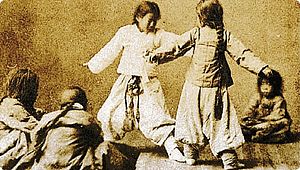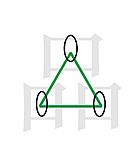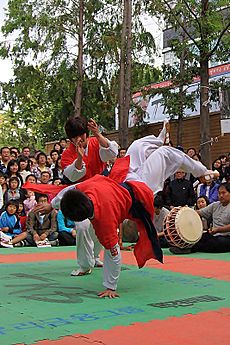Taekkyon facts for kids
[[Image: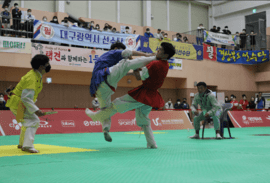 |200px]] |200px]] |
|
| Also known as | Taekgyeon, Taekkyeon, Taekkyon |
|---|---|
| Focus | Self-defense with a focus on kicks, trips, throws in competitions |
| Hardness | Light-contact (pushing hands) Full-contact (strikes, kicks, throws, takedowns etc...) |
| Country of origin | Korea |
| Parenthood | Subak |
| Official website | Four associations:
|
| Taekkyon | |
|---|---|
|
UNESCO Intangible Cultural Heritage
|
| Popular spelling | |
| Hangul | |
|---|---|
| Hanja | |
| Revised Romanization | Taekgyeon |
| McCune–Reischauer | T'aekkyŏn |
| IPA | tʰɛk̚k̕jʌn |
| Dictionary spelling | |
| Hangul | |
| Hanja | |
| Revised Romanization | Taekkyeon |
| McCune–Reischauer | T'aekkyŏn |
Taekkyon (pronounced "tek-kyun") is a very old Korean martial art. It's also known as Taekgyeon, Taekkyeon, or Taekyun.
This martial art is special because of its smooth, flowing foot movements. These are called pum balki, which means "stepping-on-triangles." Taekkyon uses both hands and feet. It helps you unbalance, trip, or throw an opponent. People who practice Taekkyon are called "Taekkyon-kkun."
Taekkyon is seen as a living link to Korea's past. Many people think it's the oldest martial art from Korea. It almost disappeared during the time Japan ruled Korea. But it was rediscovered after the Korean War. Taekkyon even influenced the name and ideas behind Taekwondo.
It was the first martial art to be listed by UNESCO as an Intangible Cultural Heritage. It's also recognized as the 76th Intangible Cultural Property of South Korea.
Contents
Taekkyon: A Look at Its History
We don't have many old records about Taekkyon. It's described as a martial art. It might have come from older Korean fighting styles like Subak. Or it could have started as a folk game. The first time "Taekkyon" was written down was during the Joseon Dynasty. This was in a book called Jaemulbo (or Manmulbo), around the late 1700s.
The book said that old fighting contests were like the Taekkyon of that time. The word Taekkyon was written in Hangul, which is the Korean alphabet. This shows it was popular among regular people. Other old terms were written in hanja, which are Chinese characters.
Song Deok-gi was a very important person for Taekkyon in the 1900s. He wrote that no one knows exactly when Taekkyon started. But he said people practiced it until the end of the Korean kingdom.
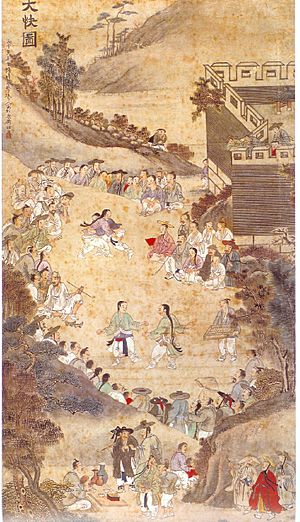
The first time a Western person wrote about Taekkyon was in 1895. This was in a book called Korean Games by Stewart Culin. In 1921, another book called Haedong Jukji called Taekkyon "flying leg technique."
Taekkyon was very popular during the Joseon period. There were two types: one for fighting used by soldiers, and one as a game. The game version was very popular with common people, often played with Ssireum (Korean wrestling). Both sports were often part of festivals. For example, during the Dan-O-Festival, there was a Taekkyon tournament. If a player beat five opponents in a row, they could rest and join again later.
Over time, Taekkyon became less popular. This was because a new way of thinking, called Neo-Confucianism, spread among the rich and powerful. By the early 1900s, it was only practiced in the capital city, Hanyang (now Seoul). When Japan took over Korea, they banned Korean fighting styles. This almost made Taekkyon disappear completely.
After the Korean War, only one master of Taekkyon was left: Song Deok-gi. He had learned the traditional way and kept practicing in secret during the Japanese rule. He helped bring the art back to life. The style he practiced was called "Widae." Song Deok-gi was key to saving Taekkyon. Most of what we know today comes from him. He became known as "the Last Taekkyon Master of the Joseon Dynasty." This was after he showed his skills in 1958 for the president's birthday.
Song Deok-gi taught a few students. They then taught others. In 1983, thanks to his student Shin Han-seung, the Korean government recognized Taekkyon. It became "Important Intangible Cultural Asset No. 76." It's one of only two Korean martial arts with this special status. Song Deok-gi and Shin Han-seung were even called "living national treasures" by the government.
Since then, Taekkyon has become popular again. There are university clubs and new schools. The government and different groups are helping to promote it. The first modern Taekkyon competition happened in Busan in 1985. Now, there are different Taekkyon schools. Some follow Song Deok-gi's original teachings. Others, like Shin Han-seung's followers, focus more on making it a sport for the world stage.
Song Deok-gi passed away in 1987 at 94 years old. In 2011, UNESCO recognized Taekkyon. It was added to their Intangible Cultural Heritage List. It was the first martial art to get this honor, along with Ssireum.
Taekkyon Techniques
Taekkyon uses many different moves. These include kicks, hand strikes, knee and elbow strikes, and attacks to pressure points. It also has throws, joint locks, headbutts, and grappling. Your whole body works together in every movement.
Even though Taekkyon is known for kicks and strikes, it also has throws and grappling. These help to complete its fighting style. The main goal of Taekkyon is to catch your opponent off guard. You use your whole body's weight. You also use their own attack against them.
The basic steps are like geometric shapes. They are the foundation for all advanced moves. All movements feel natural for the human body. Taekkyon movements are fluid, meaning practitioners are always moving. One unique move is called gumsil or neung-cheong. This is a constant bending and straightening of the knees. It makes the art look like a dance. This movement is also used in the Korean mask dance Talchum. So, both arts look a bit similar. The fighter constantly changes their stance, moving forward and backward. Their arms are up, ready to guard, blending with leg movements.
Taekkyon has forms that change and grow. One form can be done in many ways. This happens as you train for about ten years. Teachers can also create their own ways to teach the basic Taekkyon system.
Pumbalbki: The Unique Footwork
The most special part of Taekkyon is its triangular footwork. It's called pumbalki or pum balbki (품밟기). It looks like a dance. "Pum" refers to the triangular shape of the Korean character 品. So, pumbalki means "to step the Pum."
Taekkyon's pumbalki makes an equilateral triangle (△). You practice it in one spot. But in a real fight, you move forward and backward all the time. This footwork is smooth and rhythmic. It helps you quickly shift your body's weight. It also makes your waist and lower body stronger. And it helps you combine attacking and defending.
Hwalgaejit: Swinging Arms
Hwalgaejit looks like a bird's wings moving. Your shoulders open naturally. This movement must flow smoothly with your footwork. It helps improve your reflexes, quickness, and balance. It also helps distract your opponent before you counterattack. Hwalgaejit is mostly used for defense, to block or catch an opponent's hit. These movements transfer power from your body to your arms. This makes your actions quicker and stronger.
Baljil: Kick Techniques
Taekkyon is famous for its leg techniques. Old stories called it "one-hundred godlike flying leg skills." Modern Taekkyon schools teach many kinds of kicks. These include low, medium, and high kicks, and even jumps. There are sweeps with low kicks using the ball of the foot or heel. There are also flowing, crescent-like high kicks.
Many kicks move the leg outward from the middle, called gyeot chigi. Others move inward from the outside, using the side of the heels and feet. The art also uses tricks like inward trips, jumping off walls, fake-outs, and slide-stepping.
Sonjil: Hand Techniques
Even though Taekkyon is known for kicks, it uses many hand techniques too. These target all parts of the body. They use every part of the arm: forearm, elbow, hand edge, back of the hand, and fingertips. Hand techniques must work with pumbalki. This way, the springing power can go to your upper body. You often use your palm or fist to strike.
In the past, hand techniques were used for self-defense. Today, the three main schools only teach them at an advanced level. This is part of "Yetbeop Taekkyon" (Old style Taekkyon).
Taejil: Throwing and Tripping
Taekkyon includes ways to throw an opponent forward or backward. Once your opponent is off balance, you can follow with a throw or a trip. The key is to use your opponent's own power against them.
Ttanjuk: Joint Locks
These techniques are for locking and twisting an opponent's joints. You can counter an opponent's attack by locking a joint. Then, you follow up with a hand or leg attack.
Taekkyon as a Sport
Taekkyon matches have become a modern sport. Tournaments are held by the three main schools all over Korea. It's also an official sport in the Korea National Championships.
When Taekkyon is played in competitions, it uses fewer techniques. It focuses only on grappling and kicking. You score points by throwing or tripping your opponent to the ground. You can also score by pushing them out of the ring. Kicking them in the head also scores points. But there are no hand strikes or headbutts. And it's against the rules to try and hurt your opponent on purpose. Head kicks are often sharp, but usually not with full power. Fighters don't try to wear down their opponent with body blows like in Boxing or Muay Thai.
Matches are sometimes decided by who scores two points first. But different groups have slightly different rules. Contestants move around each other, constantly changing their footwork using pumbalkki. They might fake low kicks before suddenly attacking.
Modern Taekkyon Today
There are several Taekkyon groups in Korea and around the world. Here are some of them:
- The Widae Taekkyeon Preservation Society: Also called World Wide Taekkyon Organization (WWTO). It's based in Seoul and Los Angeles. It's led by Lee Jun-seo and Ko Yong-woo. They were two of Song Deok-gi's oldest students. This group was started by Song Deok-gi and Lee Jun-seo in 1983. They stick to the original teachings and don't use the sport changes made in the 1980s.
- The Korea Traditional Taekgyeon Association (KTTA): This group is in Chungju, so it's sometimes called Chungju Taekkyon. It's led by Jeong Kyung-hwa. He was named a "living national treasure of the second generation" in 1995. He was Shin Han-seung's main student. The KTTA helped Taekkyon become recognized as a UNESCO Intangible Cultural Heritage.
- The Korea Taekkyon Federation (KTF): Sometimes called Daehan Taekkyon. It's based in Seoul Olympic park. It was started in 1991. This group has been part of the Korea Olympic Committee since 2007. As a national group for Taekkyon, they organize national championships and sports festivals every year. This is the largest and most developed Taekkyon group in Korea and other countries. This school helped shape how people see Taekkyon today. They show it as a non-violent folk-game that focuses on kicks.
- The Kyulyun Taekyun Association (KTK): This group is in Seoul and started in 2000. It's led by Do Ki-hyun. He mainly learned from Song Deok-gi after starting with Shin Han-Seung. This school is famous for its annual "Taekyun Battle" tournament. It's one of the most important tournaments in Korea.
Taekkyon is also practiced in many countries. These include Australia, China, France, Germany, Japan, the United Kingdom, and the USA.
Taekkyon: Myths and Facts
There's a common idea today that Taekkyon is just a kicking game. People also sometimes think it's an "ancient version of Taekwondo." This idea spread because Taekwondo became Korea's national martial sport after the Korean War.
Because of this, many people learned about Taekkyon through Taekwondo. But this information was often incomplete. It focused only on Taekkyon's kicking techniques. Even though Taekwondo claims to be linked to Taekkyon, and even used part of its name, the two styles are very different. In fact, Taekkyon groups say they have no connection to Taekwondo. They clearly deny any link.
See also
 In Spanish: Taekkyon para niños
In Spanish: Taekkyon para niños
- Korean martial arts
- Song Deok-gi
- Korean culture


